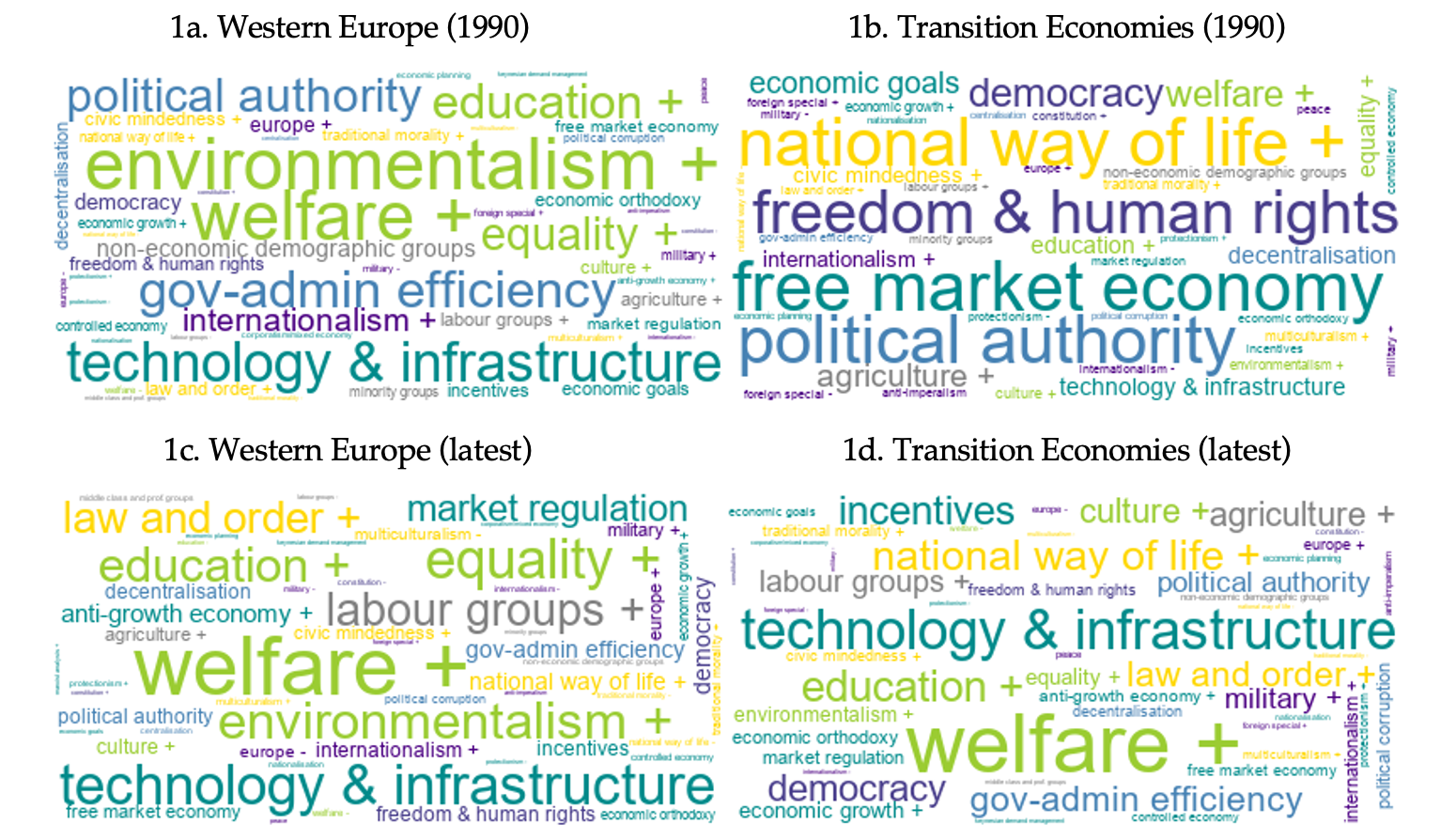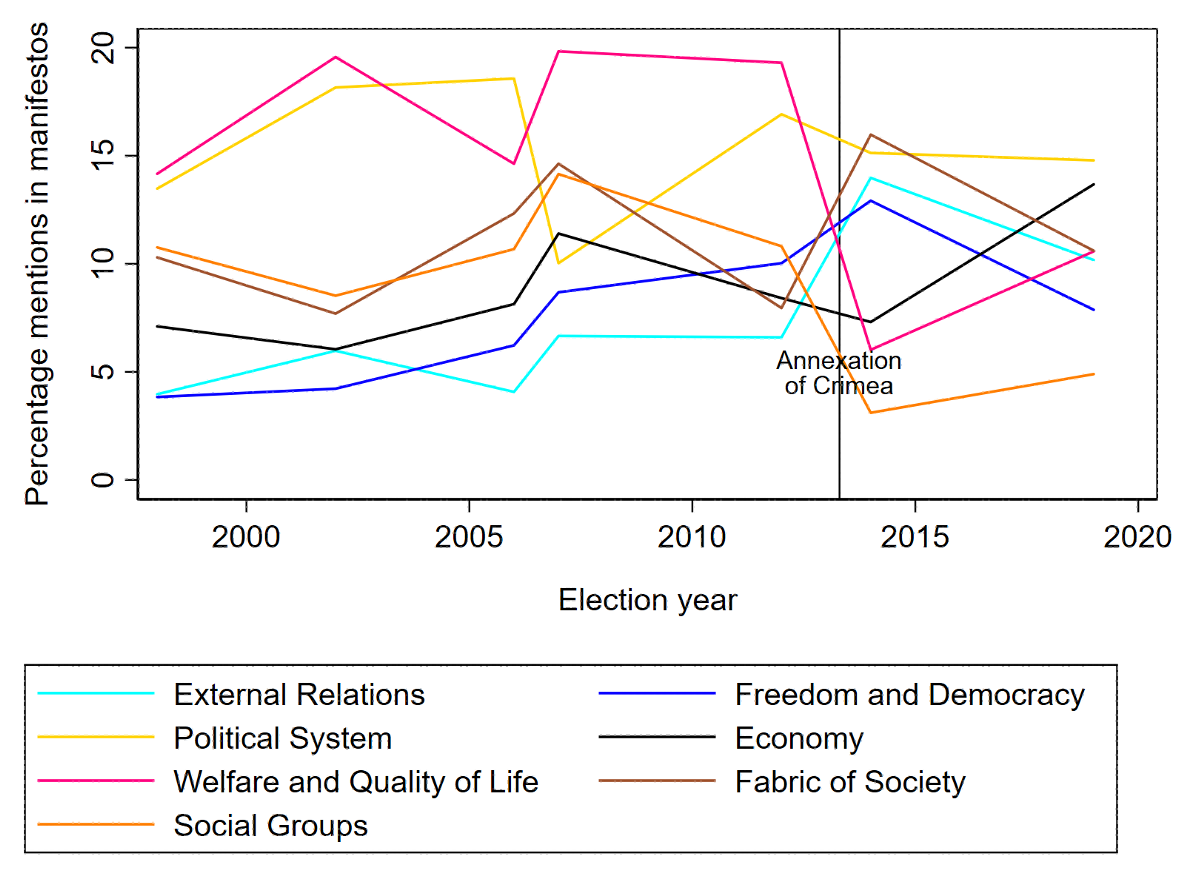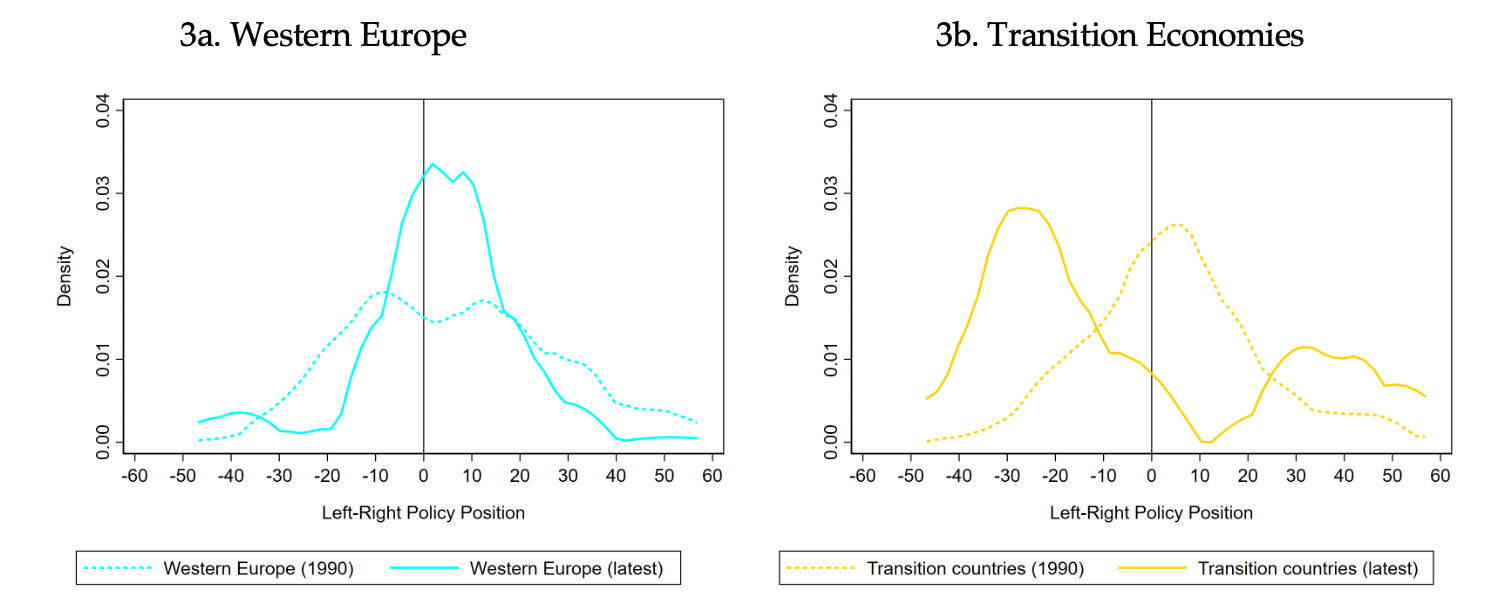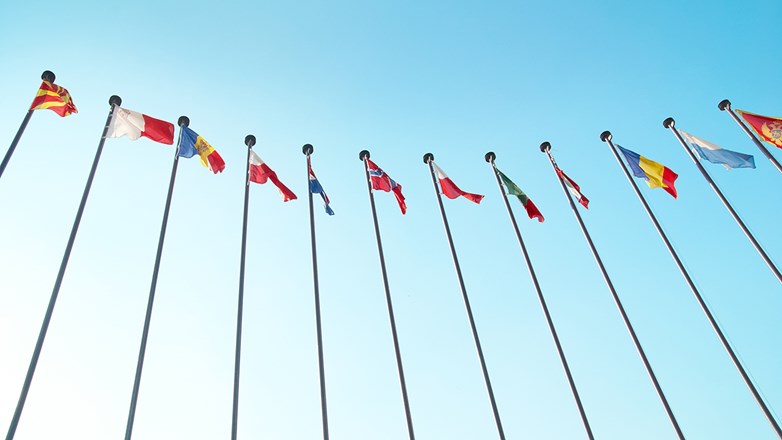European democracy through the lens of party manifestos
The subjects of political discourse are important but hard to quantify. This brief uses data from 30 years of party manifestos to study how the dominant topics in politics have evolved across Europe. Transition countries have seen the most significant shift in the content of political discourse. In the early 1990s, party manifestos in Eastern Europe focused on a distinct set of topics related to transition; by recent elections they had converged to those in Western Europe, with a heavy emphasis on the welfare state, education, infrastructure and technology. Political discourse can change rapidly in times of crisis as shown by the example of Ukraine.
The dominant topics in politics are not always as apparent as when Bill Clinton was elected US president in the midst of a recession. While it is easy to track winners across election cycles, it is much harder to know what got them elected and what they will do (or at least, promise to do) once in power. The key issues and topics that political parties and candidates talk about form as important a part in our democracies as vote shares.
In this brief, Jonathan Lehne and Maiting Zhuang use data collected by the Manifesto Project (Lehmann et al., 2022) to describe the development of political discourse across Europe, with a particular focus on the differences and similarities between western European countries and transition economies in Eastern Europe.
Political manifestos as data
In most countries, voters mainly participate in the democratic process by voting for candidates put forward by political parties. Political parties advertise themselves to voters and distinguish themselves from each other by issuing party programmes or party manifestos where they lay down their ideological and policy positions.
The Manifesto Project provides a publicly available dataset on parties’ policy platforms. The data are based on the manifestos of parties that have won at least one (Western Europe) or two seats (transition countries) in a national election. Coders manually analyse the content of the manifestos and provide the percentage of each party’s manifesto that falls into one of 56 content categories. These content categories summarise a party’s policy position on given issues, for instance, whether they favour environmental protection or an expansion of the welfare state or oppose protectionism or multiculturalism.
The Manifesto Project is an example of “text as data“. Quantitative analysis based on text is becoming increasingly important across the social sciences (Gentzkow et al., 2019) but it is particularly useful in political economy and political science given that “language is the medium of politics“ and objective numerical data are often limited (Grimmer and Stewart, 2013). Unlike many recent approaches which process data using automated text analysis tools, the Manifesto Project relies on the judgement of coders from over 50 countries who read the original text. The resultant dataset has limitations: the subjective choices made by individual coders, the to-some-extent arbitrary determination of content categories to summarise the most relevant issues across different contexts and time periods and the difficulty of imposing consistent classifications for texts written in over 40 languages. Despite these caveats, it is a unique resource for analysing the evolution of countries’ political discourse over time and across countries.
Key issues in political discourse
Figure 1 summarises, through content categories, the policy positions of parliaments in Western Europe and transition countries at two points in time: the early 1990s (around the time of the first democratic elections in most transition countries) and after the latest election. We measure the importance of a policy position in a country’s parliament by weighting the importance of the relevant content category in each party’s manifesto by that party’s vote share. Over time, our measure of a policy position’s importance in political discourse may increase or decline for two reasons. First, parties may change the extent to which they emphasise a given position in their manifestos. For example, parties across the political spectrum are likely to have increased references to healthcare in their manifestos during election campaigns held during the Covid-19 pandemic. Second, as voters’ preferences shift, parties that gain support will see their issues receive greater weight in the aggregate measure relative to parties that lose vote shares. For example, if the pandemic shifted voters’ preferences towards a more comprehensive welfare system, voters could respond by voting for parties which discuss the expansion of the welfare state in their manifestos.
Figure 1. Policy positions of parties in parliament.

Source: The Manifesto Project and authors’ calculations.
(Notes: This chart shows word clouds of the main topics that feature in the manifestos of political parties in parliament, weighted by each party’s vote share and averaged across countries within a region. Panels a and b are based on the first election after 1990 (and before 1995) and Panels c and d are based on the latest election (after 2015) in the sample. Western Europe includes Austria, Belgium, Denmark, Finland, France, Germany, Greece, Iceland, Ireland, Italy, Luxembourg, Netherlands, Norway, Portugal, Spain, Sweden, Switzerland and the United Kingdom. Transition economies include Armenia, Azerbaijan, Bosnia-Herzegovina, Bulgaria, Croatia, Czech Republic, Estonia, Georgia, Hungary, Latvia, Lithuania, Moldova, Montenegro, North Macedonia, Poland, Romania, Russia, Serbia, Slovakia, Slovenia and Ukraine. Not all countries are represented in both periods.)
Some striking patterns emerge. While the policy priorities of Western European parliaments remain relatively stable over the past 30 years, those of transition countries have changed markedly. During the transition period, many parties focused on the political and economic aspects of transition. Support for democracy, freedom and human rights, as well as the free market economy, featured heavily in the manifestos of parties that formed the first democratic parliaments. Over time, policy priorities in transition countries have become more similar to those of their western neighbours, and issues such as the expansion of the welfare state, the provision of education, and the importance of technology and infrastructure, have come to the fore in all countries.
Nevertheless, some differences still remain. For instance, environmental protection is one of the most important topics in western European parliaments, though its importance has declined over time. In transition countries, the environment is slowly becoming more important, but even in the latest elections it ranked at only number 16 out of 56 issues. In contrast, support for the “national way of life” was and continues to be a prominent part of the political discourse in transition economies and it is also becoming more mainstream in the Western European countries.
Political corruption and governmental and administrative efficiency have become relatively more important issues in the parliaments of transition countries, both over time and relative to their western neighbours. Meanwhile, parties in Western Europe are devoting more of their manifesto to calls for equality and social justice.
A closer look at Ukraine
A country’s parliament’s policy platform can change suddenly in response to shocks. Figure 2 shows the big topic groups in the manifestos of political parties in the Ukrainian parliament from 1998 to 2019. The parliamentary election in October 2014 closely followed the Euromaidan Revolution, the annexation of Crimea by Russia and the start of the Donbas war. Compared to the previous elections, external relations became a major issue in the Ukrainian parliament, driven in particular by increased mentions of the military and the relationship with the EU. Party manifestos heavily featured appeals to Ukrainian nationhood, national solidarity, and unity (as evidenced by the increasing importance of the content category “Fabric of Society”). The trend of increasing attention to freedom and democracy also continued in this election cycle. In contrast, the previously most important issues in elections (welfare and quality of life) received much less attention in parliament at times of political upheaval and military conflict.
Figure 2. Topics in Ukrainian elections.

Source: The Manifesto Project and authors’ calculations.
(Notes: This chart shows the percentage of mentions of topic groups in the manifestos of political parties in the Ukrainian parliament from 1998 to 2019, weighted by each party’s vote share.)
Distribution of political ideology
While the previous section discussed the main policy issues in parliament, we now turn our focus to the ideology of individual political parties that make up a country’s parliament. A commonly used summary measure of political ideology is a left-right scale (RILE), where left positions favour peace, state intervention in the economy and the expansion of the welfare state and right positions support security, traditional values and the free market economy. The Manifesto Project provides a RILE value for each party at each election (based on Laver and Budge, 1992), which is calculated by subtracting the share of a party’s manifesto devoted to left-leaning policy issues, for instance support for the welfare state, from right-leaning content, such as support for the free market economy. Condensing the complexity of party programmes into a one-dimensional measure based on fixed definitions has advantages and drawbacks. The RILE makes it possible to compare diverse political parties that campaign on different issues (for instance ecological parties compared to nationalist parties) and measure how the same party’s policy stance may have shifted over time. As the definition of left- and right-leaning issues were based on influential political theories around the 1900s, some scholars argue that this measure has become less appropriate to empirically differentiate between modern political parties, particularly in transition countries (see, e.g., Mölder, 2016). In particular, Tavits and Letki (2009) show that during the transition process many leftist parties in Eastern Europe pursued economically right-wing policies and Vachudova (2008) argues that right-wing parties in the region often appealed to a nationalist discourse.
With these caveats in mind, Figure 3 shows the distribution of all parties in parliament in the Manifesto Project database on the RILE scale, weighted by their respective vote shares. In Western Europe in the 1990s, the chart shows the prominence of both centre-left and centre-right parties, as well as smaller parties both on the more extreme left and right. In contrast, the parties in parliament in transition economies at the time were more concentrated in the centre (and slightly towards the right). Fast forward 30 years and the distribution of political ideology has changed in both the east and the west. In Western Europe, the majority of parliamentarians are now situated slightly right of centre with little mass in the more extreme tails. In contrast, in the former transition countries, there is evidence of political polarisation with party representation moving both to the left and the right on the ideological spectrum and relatively few parliamentarians occupying the centre.
Figure 3. Left-right position of parties in parliament.

Source: The Manifesto Project and authors’ calculations.
(Notes: This chart shows the density of parties in parliament on the left-right policy scale (RILE), weighted by each party’s vote share within their country. The dashed lines are based on the first election after 1990 (and before 1995) and the solid lines are based on the latest election (after 2015) in the sample. Western Europe includes Austria, Belgium, Denmark, Finland, France, Germany, Greece, Iceland, Ireland, Italy, Luxembourg, Netherlands, Norway, Portugal, Spain, Sweden, Switzerland and the United Kingdom. Transition economies include Armenia, Azerbaijan, Bosnia-Herzegovina, Bulgaria, Croatia, Czech Republic, Estonia, Georgia, Hungary, Latvia, Lithuania, Moldova, Montenegro, North Macedonia, Poland, Romania, Russia, Serbia, Slovakia, Slovenia and Ukraine. Not all countries are represented in both periods.)
Conclusion
What are the main topics of political discourse? Are they different across countries? Do they change over time? While there is no perfect way to quantify and track political discourse over time, this brief uses data from parties’ manifestos provided by the Manifesto Project to illustrate some broad trends across Europe over the past 30 years.
We document two kinds of changes in the subject matter of party manifestos. First, there are gradual shifts in content that reflect underlying developments in society. As democracies have matured in Eastern Europe, the content of their parties’ manifestos has evolved away from the immediate concerns of economic and political transition and converged to those of Western European parties. Second, more abrupt shifts can arise when countries experience crises or institutional upheaval. Over the past decade Ukrainians have lived through a revolution, the Donbas war, and the ongoing Russian invasion. Most of the parties that represent them in parliament are new, and the issues that feature prominently in their manifestos are now markedly different from those before the Euromaidan revolution.
Manifestos are not just about substance but also about ideology. Using the Manifesto Project’s classification of parties on a left-right scale, we show how the distribution of parties has evolved in Western Europe and transition countries. By this measure, political polarisation has been increasing in transition countries where centrist positions are less well represented than in Western European parliaments.
References
Disclaimer: Opinions expressed in events, policy briefs, working papers and other publications are those of the authors and/or speakers; they do not necessarily reflect those of SITE, the FREE Network and its research institutes.
Photo: Beautiful landscape, Shutterstock




